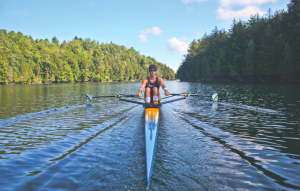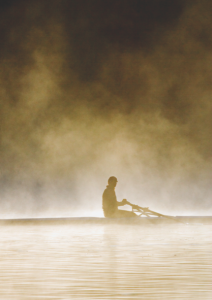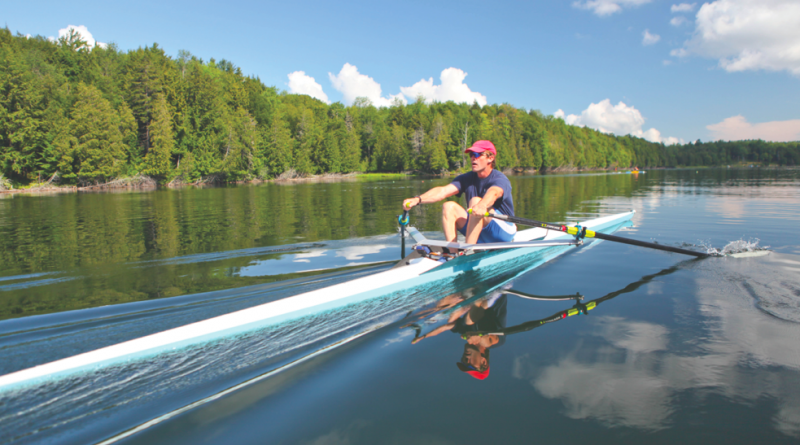The art of sculling
By JENEVRA WETMORE
CRAFTSBURY COMMON — “Imagine trying to learn how to hit a golf ball while also standing on a teeter-totter that’s only 12 inches wide … in the middle of a lake.”
This was the picture Noel Wanner, one of the associate directors and head coaches at the Craftsbury Outdoor Center, conjured when describing sculling to me, a complete novice.
Now I am sitting on the mirror-like waters of Big Hosmer Pond, a 2.25-mile long lake a few miles outside the village of Craftsbury Common, in a boat so narrow my knees are knocking together — and that’s not just because I’m nervous; it’s a tight and precarious perch just sitting there.
Holding two oars purposely weighted to challenge my balance, Wanner’s description seems all too accurate. The narrow boat rocks side to side as my guide, Jamie Chapman, keeps hold of the bow. Her presence supplies a false sense of comfort as she instructs me to slide forward in the boat, while warning me with a smile: “You’re probably going to flip.”
I am participating in what coaches at the Craftsbury Outdoor Center call “the flip test,” an experience everyone learning to scull at the center must undergo before getting in a boat more suited to their expertise level. With no training and in a boat as narrow as mine, flipping, the goal of the test, is inevitable.
In no time at all — as I am just sitting there trying not to move— one oar dips into the water at an angle I find impossible to recover, tilting the boat steeply to the right and propelling me into the water. The full six minutes I spend floundering to get back into the boat with Jamie’s instruction finally result in success, and I am brought back to the dock.
Although the experience has been a distinct reminder of the difficulty of sculling, I already feel much more confident being in the boat on water and am eager to try again and, hopefully, join the ranks of the few who gain proficiency. It is a goal within my grasps but, as Wanner tells me, I most probably have a long way to go to get good.
“It’s not very hard at all to learn to scull passably,” he says, speaking from his years of experience coaching, “but it’s extremely hard to become proficient at it.”
 TRAINING GROUNDS FROM THE START
TRAINING GROUNDS FROM THE START
The Craftsbury Outdoor Center began in 1976 when the Spring family purchased the land, which was then the Cutler Academy campus. They converted it into a center for athletes by creating a Nordic ski trail and adding running and sculling camps. With the addition of sculling camps the Center became the first rowing camp in North America.
It remained a small family business until Dick Dreissigacker and Judy Geer purchased it in 2008. Dreissigacker is one of the founders of Concept2, a company he started with his brother making composite racing oars, and now maker of the world’s most popular rowing ergometer, among other rowing and skiing equipment. They married and the family settled near the company’s headquarters in Morrisville, Vermont.
Geer and Dreissigacker both coached sculling camps at the center and their three children skied there during the time the Springs owned it. The couple wanted other families to have the same experience at the center that they did, so they looked into purchasing the center and growing its market.
It was not a rushed process. Dreissigacker and Geer discussed the future of the Center with the Springs for almost two years, hoping to continue the Spring’s original vision while adding new elements of their own. They eventually became the directors of the Center, converting it into a nonprofit organization with the mission of supporting lifelong participation in sports, teaching sustainable practices, and protecting the surrounding land.
Dreissigacker, a 1972 Olympian, and Geer, a three-time Olympian in the 1970s-80s, were themselves familiar with the struggle of becoming a professional athlete. “It was different back then,” Judy recalls, “There was not a lot of money or support and you had to find a job that would get you trained and try to make it all work.”
To that end, the duo started The Green Racing Project, or GRP, which provides what Geer wishes she had been able to access at that stage in her life: a healthy place to train with absolute dedication, while simultaneously developing skills for later life.
The project supports roughly 40 elite Nordic skiers and scullers who are recent college graduates; they train and live at the Center year-round. Athletes who are part of GRP also work for the center, helping to coach beginner scullers, clear running and skiing trails, and plan new ecologically friendly buildings. These skills, Geer hopes, help the athletes achieve a balance of physical and mental work.
According to Russell Spring, current General Manager of the Craftsbury Outdoor Center and son of the original owners, the Green Racing Project is the largest change the center has seen since becoming a nonprofit. Three women from the Nordic ski and biathlon GRP program raced at this year’s Sochi winter Olympics and multiple Green Mountain Project athletes from the sculling program have competed in the World Rowing Championships in past years. Four boats have qualified for the Championships this year, two of which have all athletes from Craftsbury Outdoor Center.
In just six years since the Green Racing Project began, Craftsbury Outdoor Center has become a hub of Olympic activity, sending new athletes competing in Nordic skiing, biathlon, and sculling to national competitions every year. The system is unique not only because of the professional athletes it supports, but also in part due to the presence of past Olympians as coaches at the Center. Among their coaches are Carol Bower, 1984 Olympic gold medalist for rowing, and Pepa Miloucheva, 1994 gold medalist in the World Ski Orienteering Championships.
Training camps for all
While providing a training ground for the best-of-the-best, the Center has also kept its original reputation as a place for beginners to learn to scull — now with the help of expert coaches. The five-to-one student-to-coach ratio is set up to support all ages and levels of expertise. Rick Ricci, one of the associate directors at the center, described the coaching mission as inclusive and thorough.
“We work hard to make sure no one gets missed,” he said. “We make sure that we’re talking to everybody at the level they need to be spoken to.”
Participants in the sculling camps pay to live at the center and learn to scull or, if they’ve sculled before, improve their skills. These camps, with housing and locally sourced meals provided, last for a weekend up to a week. A membership at the Center also grants access to these sculling classes without attending one of the camps.
As participants in the sculling camps will tell you, the method works.
Pat Rickart, who is new to the sport, is part of the community rowing program and has been coming to the Center every Monday for lessons. She told me how much more comfortable she was already feeling in the boat after just five days of instruction.
“Every week… we’ve had some sort of individual instruction with some of the athletes,” she said, adding, “I feel like I’m getting the hang of it.” She also shared my amazement in the Olympic presence at the camp, asking “where do you go that you get to see Olympic athletes and have them teach you?”
According to Ricci, the remote setting in Vermont’s rural Northeast Kingdom, among other factors, makes the camp unique. But the center is also known for customizing its programs to the individual.
“There’s no other place in the United States like this,” Ricci told me. “It’s a combination of our history, it’s a combination of location…all that put together, the fact that we did it first. Just like anything, when you have a reputation you tend to gravitate more people toward you.”
That reputation, and the fact that the sculling world is relatively small in comparison to that of a sport like soccer, means that avid rowers are likely to have heard about the Craftsbury Outdoor Center and know of its national and international reputation.
Incredibly enough, Craftsbury coaches train hundreds of novice scullers like me to row in a racing single — that very narrow boat that I flipped — in a week’s time. Having just flipped the boat while sitting as still as possible, that prospect seemed daunting, yet exciting.
Again I thought of something Wanner had said when describing sculling to me:
“It’s a movement that, done at a recreational level, is really smooth and beautiful and rhythmic… It’s a very satisfying and fun way to be out of doors.”
Later in the day while watching the fluidity of the professional scullers out on the lake, I felt my body ache to get back in a boat for another try. Difficult at first, sculling is learned quickly and, according to Wanner, has enough complexity and challenge to it that you could spend decades mastering the art of this sport.
“Craftsbury has always been a place, one of the few places early on, where you could come and get really high quality coaching in sculling,” says Wanner. “Trying to master this very graceful, fluid motion while also being under a great deal of aerobic challenge and balance challenge — I think that’s what makes the sport kind of endlessly fascinating for people. They tend to fall in love with it.”
 What is sculling?
What is sculling?
Unlike the more familiar sweep rowing in which the athlete controls one oar and rows in teams, scullers have an oar in each hand. A sculler moves the boat by “squaring the oars,” or putting the blade perpendicular to the water, through the stroke. This stroke moves the blade of the oar from behind to in front of the sculler’s body, causing the boat to move backwards in relation to the direction the sculler is facing. The oars then come back to their original position through the action of “feathering,” or positioning the blades parallel to the surface of the water.
An experienced sculler’s oars will be able to rise above the water during this feathering action. This is particularly impressive given that the oars’ contact with the water balance the boat. The three types of sculling events—single, double, and four-person (quad)—are all practiced and taught at the Craftsbury Outdoor Center.
Sculling Programs Offered at the Center:
Sculling camps start in early summer and run through Sept. 28. The weekend programs, which last three days and two nights, cost $621. The Four-day program, lasting four days and three nights, costs $798, and the week-long program of six days and five nights costs from $1166 to $1309 depending on the season.
Hosmer Point, a day and sleep-away camp associated with Craftsbury Outdoor Center, also offers sculling programs for ages 9 and up. For more detail, go to www.craftsbury.com.
Running Programs Offered at the Center:
Run2Scull, Scull2Run, a program combining running and sculling, is a week-long and costs $1,309.
All Comers, a camp tailored to the goals of the campers—whether marathon runners, ultra runners, general fitness runners or brand new runners—lasts seven days and costs $1070.
For a shorter program, Foliage and Running Weekend lasts three days in the fall and costs $383. All other running camps are filled for the summer, but more info can be found at www.craftsbury.com.
Membership opportunity:
To become a member of the Craftsbury Outdoor Center and enjoy unlimited Nordic skiing and summer trail access visit www.craftsbury.com. Additional fees grant access to programs such as Hosmer Community Rowing Club programming and other sculling and training opportunities.

